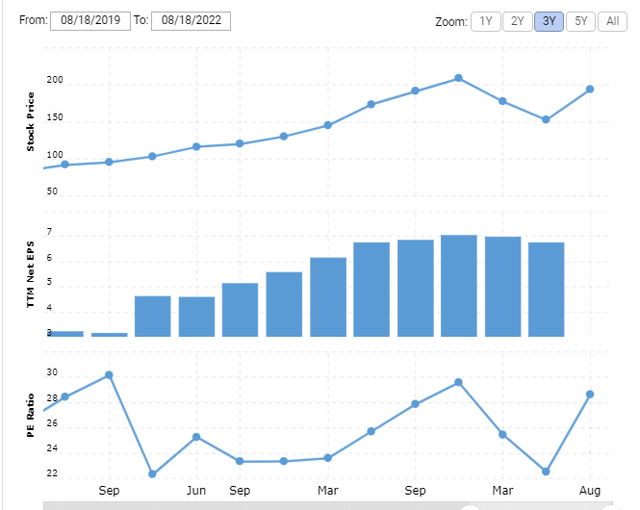Panuwat Dangsungnoen
ETFs like the Vanguard Growth ETF (NYSEARCA:VUG) have historically traded at high valuations as investors normally focused on growth trends instead of valuations. Currently, however, growth stocks lost their ability to attract investors through their blistering revenue and earnings growth trends. Therefore, it is not prudent to pay a premium on growth stocks ahead of a potential economic slowdown, higher rates, and low earnings forecasts. Meanwhile, the bulls seem to believe recession and interest rate risks are already priced in, and the selloff is done. I anticipate a rocky path ahead for growth stocks and expect the recent price surge to end up being a bear market rally.
Rally Built On False Perceptions Is Unsustainable
Rate hikes by the Fed coupled with a slight decrease in inflation led people to believe the worst is over. It’s true that inflation cooled slightly from the June high, with expectations that lower energy prices would make a further reduction in the Consumer Price Index going forward. Nevertheless, if the Fed wants to ease inflation to its targeted range of 2% to 3%, it must raise interest rates from their current range of 2.25% to 2.50% to the restrictive level where they effectively drag down economic growth. Moreover, it remains unclear how long the Fed will sustain high rates and when monetary policy will begin to ease. In short, market dynamics will probably be challenging for growth stocks and ETFs in the coming quarters as economic contraction combined with high-interest rates is one of the worst combinations for corporations, especially for growth companies that seek to generate high double-digit revenue and earnings growth.
Besides the United States, the majority of VUG’s stock holdings would also suffer from weakening economic conditions in the European region and China. In July, the United Kingdom’s CPI grew by 10.1% annually, while the Bank of England predicts that the nation will experience one of the longest recessions from the fourth quarter of 2022. Similarly, high inflation and looming recession would negatively impact consumers’ purchasing power in the eurozone. Meanwhile, China, the key revenue generation region for multinational companies, missed GDP growth expectations for the first half of 2022 by a large gap. Moreover, analysts’ full-year consensus GDP growth estimate of 3.5% shows that the country might also miss its full-year growth target of 5.5%.
Overall, it appears that investors’ bullishness is premature as the economic situation across the globe is likely to deteriorate further in the months ahead. Consequently, lower consumer purchasing power along with sluggish investments from corporations would significantly dent overall demand trends for tech and consumer discretionary companies.
Lower Earnings Forecast Limits Upside
As the economic situation is deteriorating across the globe, the impact has started appearing in lower earnings forecasts for 2022 and the next year. For the June quarter, the FactSet data shows that positive earnings surprises declined below their five-year averages. The report shows S&P 500 achieved a blended earnings growth rate of 6.7% in Q2 2022, but when energy earnings are excluded, the S&P 500’s earnings declined 3.7% from the past year period.
On both a quarter-over-quarter and year-over-year basis, Zacks estimates show a massive drop in third-quarter earnings. Earnings for the S&P 500 are expected to decline by a negative 4.5% in the September quarter from last year, with consumer discretionary, technology, and retail companies among the biggest losers. If we look at individual earnings estimates of VUG’s top 10 stock holdings, the situation does not appear to be favorable for bullish stock price movements. Other than Tesla (TSLA), The Home Depot, Inc. (HD), and Visa (V), the data of the rest of the VUG’s top 10 stock holdings indicates a large amount of downward earnings revisions for 2022 and 2023. For instance, in the last 90 days, 27 analysts lowered Apple’s (AAPL) September quarter earnings expectations.
Paying a Premium Isn’t a Sound Strategy
NASDAQ PE ratio (macrotrends.net)
Most large-cap tech stocks, particularly those from the tech and consumer discretionary sectors, are trading at high valuations. The price-to-earnings ratio of tech-heavy NASDAQ has jumped back to late 2021 levels of 28.6, up significantly from the mid-June low of 20x. If stock prices continue to rise and investors keep paying premiums on growth stocks despite lower earnings forecasts, the price-to-earnings ratio may reach a new 52-week high soon. However, I believe lower earnings, economic headwinds, and increased volatility would make it hard for investors to pay a premium on growth stocks. Last year, investors paid the premium on growth stocks because corporations like Apple, Microsoft (MSFT), and many others were reporting record-breaking revenue and earnings. Furthermore, economic and monetary conditions were significantly different from 2022.
Currently, large-cap tech stocks that have shown resilience against the tech stock route compared to small and non-profitable tech stocks are trading at significantly high valuations. According to Seeking Alpha’s quant grading system, most of the VUG’s top 10 stocks received poor valuation scores. Apple, Amazon (AMZN), Nvidia (NVDA), and Visa all received F grades, while Microsoft, Home Depot, and Alphabet (GOOG) (GOOGL) received negative D grades.
Bear Market Rally: Be Cautious
In long bear markets, bear market rallies are common. During the great depression and the dot-com bear market, the market witnessed several bear market rallies. Since the recent surge in US stock markets is backed only by sentiments rather than economic data, this could also turn out to be a bear market rally. Bulls may also find it hard to maintain upside momentum due to sluggish earnings forecasts and higher valuations. There have also been several warnings about the bear market rally from analysts and asset managers. As of the end of June, Philippe Laffont’s Coatue management held 80% of its portfolio in cash and the firm anticipates a dot-com type stock market crash. According to Coatue’s investor presentation, US stock markets are still in the middle of a bear run.
Popular hedge fund manager Michael Burry, who has consistently been sending warnings about the stock market collapse since the beginning of this year, now cautioned that the current rebound in stocks is unlikely to last due to ballooning consumer debt. In another tweet, he mentioned bear market rallies in history, suggesting the recent stock surge may be a bear market rally.
Nasdaq now up 23% off its low. Congratulations, we now have the average bear market rally. Across 26 bear market rallies from 1929-1932 and 2000-2002, the average is 23%. After 2000, there were two 40%+ bear market rallies and one 50%+ rally before the market bottomed.
In Conclusion
The recent surge in growth stocks won’t last, in my opinion, and markets might see high volatility in the months to come. As a result of weak economic conditions and higher interest rates, corporate profits will continue to decline in the coming quarters, which will keep growth stock prices under pressure. Additionally, stock prices would have little room to grow as valuations have already surged back close to their 52-week-high. Therefore, waiting for a better buying opportunity in ETFs like VUG seems like a prudent strategy


Be the first to comment